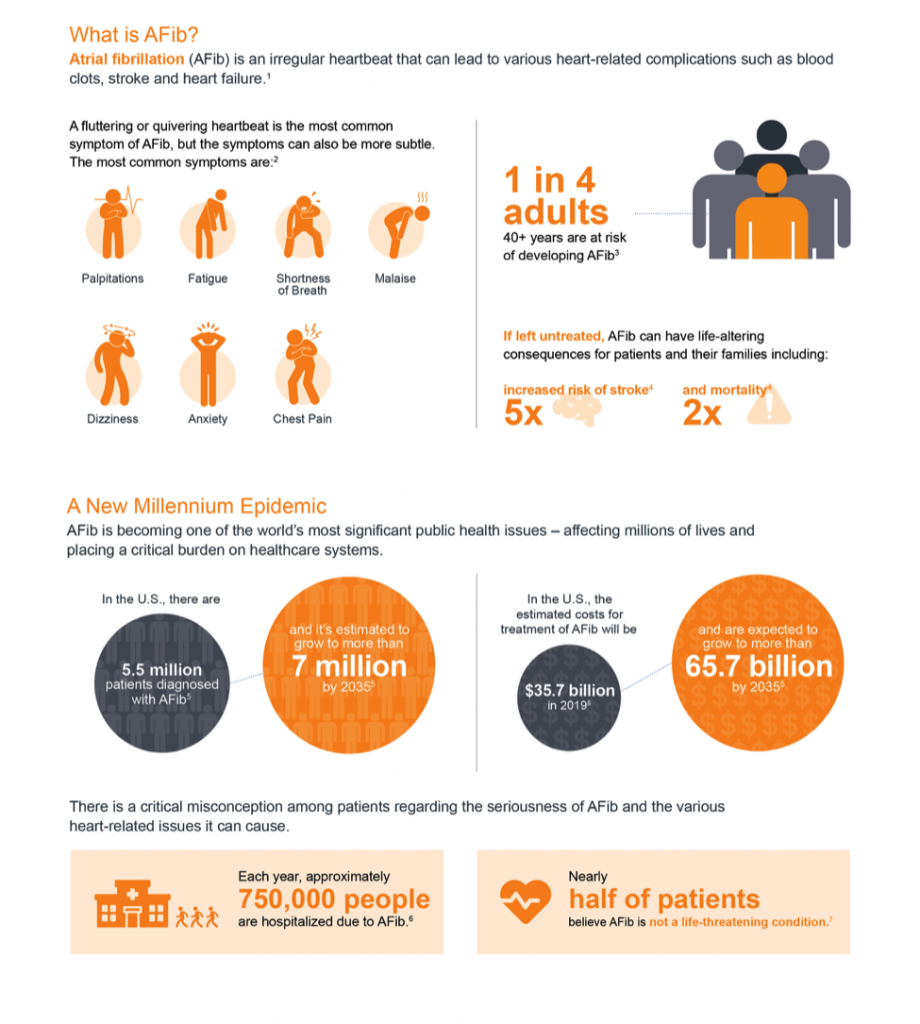Atrial Fibrillation
Atrial Fibrillation or AFib is an irregular heartbeat, typically very fast, that causes the heart to function in a chaotic and uncoordinated way. AFib is the most common cardiac arrhythmia in the United States, and it is estimated that upwards of 5 million people are living with the condition. 1 in 4 people above the age of 40 are at risk for developing AFib.
The greatest concern in AFib patients is less about the arrythmia itself and more to do with the fact that it can cause blood clots leading to strokes, heart failure symptoms and increased mortality. Due to the uncoordinated heartbeats, blood can begin to pool and clot within a heart structure known as the left atrial appendage or LAA. If a blood clot were to dislodge and enter the bloodstream, a stroke can occur. In fact, patients with AFib are the five times higher risk of stroke than those without. It is estimated that upwards of 30% of all strokes in the United States are caused by AFib.
Types of AFib
Typically, AFib begins as paroxysmal or occasional. Symptoms may occur at any time and for any duration. Typically, however, symptoms tend to get worse and occur more commonly as the condition is left untreated.
Persistent AFib typically occurs over time however some patients can develop persistent AFib from the start. This is when heart does not go back to normal rhythm on its own, without intervention. Once again, symptoms may be mild or even severe, however they do not resolve with time.
Permanent AFib occurs when the arrhythmia cannot be corrected despite multiple attempts at managing it. At this point, the symptoms of the arrhythmia may have to be managed, rather than cured.
Stages of Atrial Fibrillation
Your doctor will help determine your stage of atrial fibrillation. This is important to help formulate the best treatment option for successful control of the arrhythmia.

Treatment for AFib
There is no one size fits all when it comes to treating atrial fibrillation. Please talk to the doctor to discuss the best therapeutic option for your situation, based on your stage of the atrial fibrillation, underlying medical problems and state of your overall heart health.
In general, we begin with lifestyle change in the form of improve diet and exercise. Excess weight is a significant risk factor for atrial fibrillation and as such, some patients who lose weight and excess fat may be able to keep their arrhythmia under control. However, most patients find it quite difficult to maintain a new, improved lifestyle long-term, at which point they may be candidates for medical therapy.
Medications to control heart rhythm and heart rate are commonly prescribed for patients with paroxysmal AFib. They are easy to take and are non-invasive. However not all patients respond well to medications. Some will not see much benefit from the drug therapy while others will have unacceptable side effects. Further, the effectiveness of the medication may diminish over time requiring higher doses. Ultimately, medications do not treat the underlying arrhythmia.
For qualifying patients, the gold standard, curative procedure for AFib is a cardiac catheter ablation. This involves the destruction of heart tissue that is causing the errant electrical signals in the heart. Catheter ablation is very effective and has a relatively low risk profile. Learn more about a cardiac catheter ablation for AFib.

